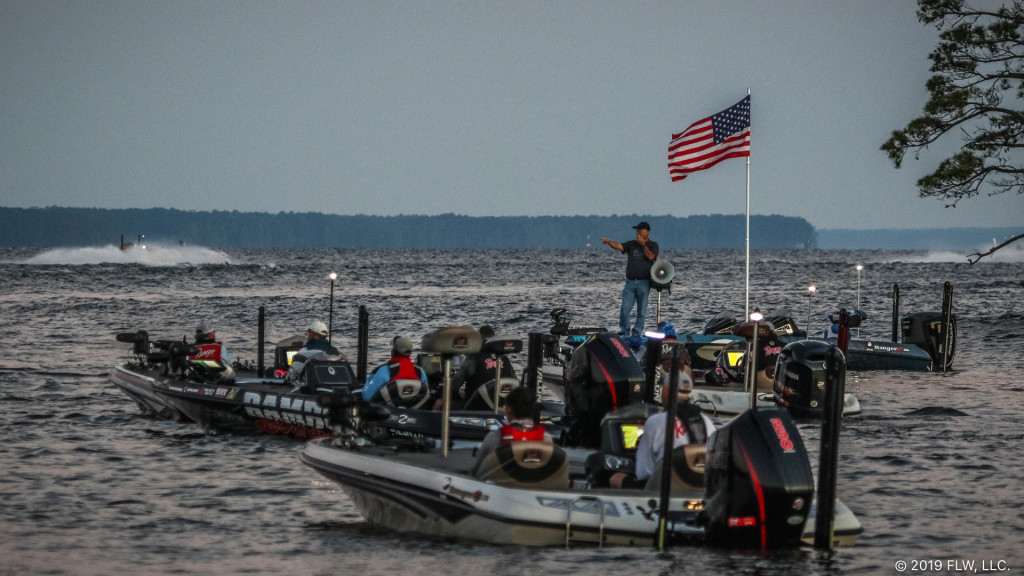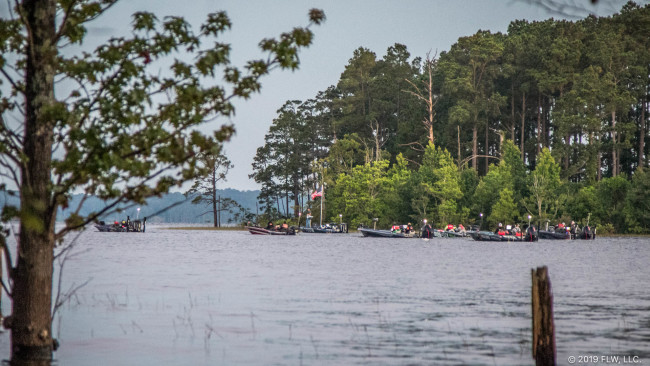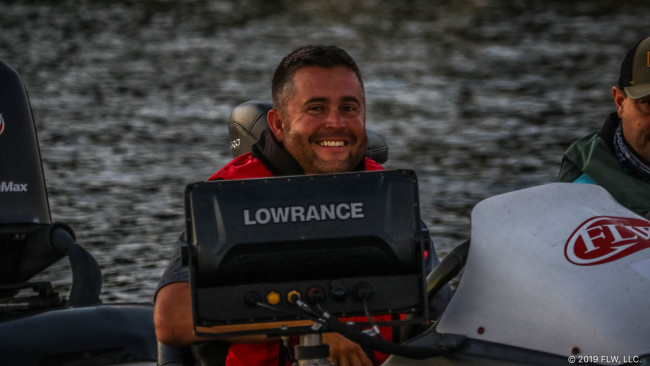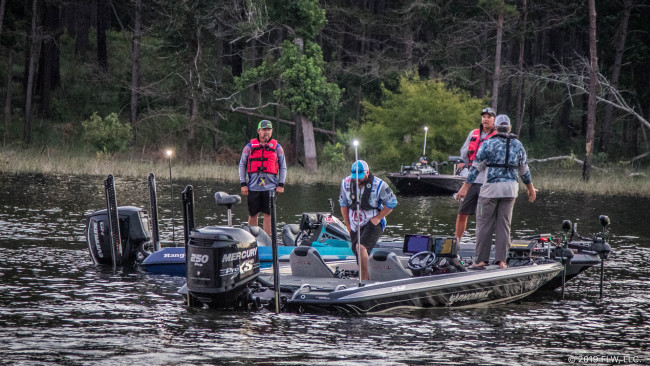Let the Rayburn Catchfest Begin
High water, shallow bass should provide a lot of fish-catching action in Southwestern Division event

If you followed the coverage of the FLW Tour event on Sam Rayburn Reservoir back in January, you know that heavy rains produced high-water conditions that opened up plenty of new territory for pros to flip and pitch.
We’re five months later into the year now, and while the water level at Rayburn has fluctuated in the months since the Tour event, it’s still about 4 1/2 feet above full pool as anglers take to Big Sam for the Costa FLW Series Southwestern Division event presented by Mercury.
The extra water has really changed the game from what would be a typical June tournament at Rayburn. Bass are piled into the bushes and hay grass, and they’re easy to catch. The offshore bite that usually dominates this time of year will still certainly be a factor, but it’s not likely to dominate the standings like it should.
Overall, fishing is fantastic at Rayburn right now. The weather is perfect for a bass derby, too.
It should be a downright wonderful week in east Texas.
About the fishery
At more than 114,000 surface acres, Sam Rayburn is the largest reservoir wholly within the state of Texas. And it’s as legendary as it is big. Rayburn is perennially one of the best bass fisheries in the country, as well as one of the all-time great tournament destinations.
The Angelina River feeds Rayburn’s bass-rich waters, which encompass plenty of fishable habitat, such as hydrilla, brush piles, flooded shoreline bushes, ditches and drains, hay grass, and lake-bottom offshore structure.
It’s an easy 20-plus-pound lake where limits that weigh in the upper 20s are common, and 8- to 10-pound bass frequently make it to weigh-ins.

Current conditions
Full pool at Rayburn is 164 feet. When the Tour event on Big Sam wrapped up on Jan. 13, the water level was 174.28 feet. It crested several inches higher a couple weeks later.
By mid-April, the water had bottomed out at about 165, only to shoot back up to about 170 by the middle of May.
Currently, the lake level is in the midst of a gradual fall. Since June 1, the water has come down about 2 feet to its current level of 168.84.
According to Texan James Biggs, the water level is the biggest factor in this tournament, and it’ll have a major influence on everything from navigating the lake to probable fishing patterns.
“As a whole, I think you’re going to see tons of five-fish limits caught,” Biggs says. “It’s very easy to run down the lake and flip bushes and catch fish. The water’s starting to pull out, and that’s going to make the fish a lot more accessible. It’s possible that, from practice to the end of the tournament, they’re going to be easier to catch as new fish follow the water out to where people can get to them.”
Last fall, Biggs says there were mats of hydrilla on Rayburn. Though he hasn’t scoured every stretch of the reservoir, Biggs hasn’t found much grass this year. He says the bass also aren’t set up offshore on brush piles and other areas like in a typical June.
Granted, this year has been anything but typical in the Lone Star State.
“Nothing is fishing normal because the water’s just been so high,” Biggs says. “I think because the water has been so high so long, the fish have gotten comfortable up shallow. I fully expect to be fishing offshore when we come to Rayburn [in June]. You still can, but it’s not what I expected.”
The tactics we’re likely to see from the majority of the field this week won’t surprise many people. Up shallow, pros will flip and pitch all types of flooded cover, swim a jig or buzz frog around hay grass, work hollow frogs in flooded willows, and possibly sling a spinnerbait around if there’s a little breeze. Out deep, pros will probably crank, wind a swimbait, or fish Texas and Carolina rigs.
The ratio of offshore to shallow anglers in the top 10 is tougher to predict. Biggs figures two-thirds of the top 10 will fish shallow.
“I think there’s going to be a lot of people who get their heart broken offshore,” he says.
Results from last weekend’s T-H Marine FLW Bass Fishing League Cowboy Division event on Rayburn back up Biggs’ prediction. Louisiana’s Rylon Ganey flipped and pitched bushes and hay grass to catch a winning stringer worth 20 pounds, 11 ounces.
In addition to the water level, weather conditions look ideal for the week, with daily highs around 90 degrees, no precipitation and mild winds that should make getting around on the lake very easy.

Critical factors
- Falling water – Biggs says there are inaccessible areas on Rayburn where the water reaches 50 feet or so behind the tree line. As the water falls, bass tucked way up in those areas should start to retreat back toward deeper water, putting them in position for anglers to flip them out of shallow cover.
- Inconsistent offshore – There are enough giants out deep on Rayburn for this tournament to be won by someone fishing strictly offshore. Biggs is skeptical of that approach, though. He says the offshore bite seems inconsistent because the water is dingy and there is so much cover up shallow that bass are sticking to the flooded areas. There simply aren’t as many fish out deep as is normal for June. Still, if a pro can find a sizable school out deep or an offshore pattern, they could score quickly while everyone else gets lost in the woods. Or, what’s more likely is a deep/shallow combo game plan resulting in a win.
- Tough-to-find shallow giants – Catching a low “teens” bag on Rayburn is practically easy right now, especially for the caliber of anglers fishing this event. Getting into the upper teens or over 20 pounds is more difficult because the biggest bass are so spread out. Catching a couple of 5-pound-class fish each day will be the difference maker.

Dock talk
Ganey’s 20-11 winning limit in the BFL is a little light for Rayburn in early June. It took 16 pounds to make the top 10 in that tournament, and 13-10 to make a check, both of which are also a little low for the locals who fish this lake.
Biggs figures weights will improve as the water falls.
“I’d predict 60 to 65 pounds to win,” he says, “and probably a two-day total of 27 to cut a check. So about 14 pounds a day to get paid, and I think one guy will probably have 64, so about 21 a day. That guy may have 28 and turn around and have 12. That’s the thing; if he’s offshore fishing that very likely could happen.
“In my mind, everything tells me you win deep on Rayburn. It’s hard to win flipping because it’s hard to find those good bites. But I really believe two-thirds of the guys who cut checks will be shallow. I think the winner will be fishing deep some.”
A winning stringer could come from just about anywhere on the reservoir right now, though the traditional best stretches – about five miles each side of Cassels-Boykin Park in the mid-lake area – will probably draw most of the attention.
Where and how this tournament gets won will be settled on Saturday. In the meantime, this should be one of the more exciting tournaments to follow this year, as Big Sam is being generous with its bass, and the Southwestern Division’s best pros are ready to get after them.
Tournament details
Format: All boaters and co-anglers will compete for two days. The top 10 boaters and co-anglers based on cumulative weight after two days of competition will advance to the third and final round, with the winner determined by the heaviest cumulative three-day weight.
Takeoff Time: 6 a.m. CT
Takeoff Location: Umphrey Family Pavilion, 5438 RR 255, Brookeland, Texas
Weigh-In Time: 2 p.m. CT
Weigh-In Location: Umphrey Family Pavilion